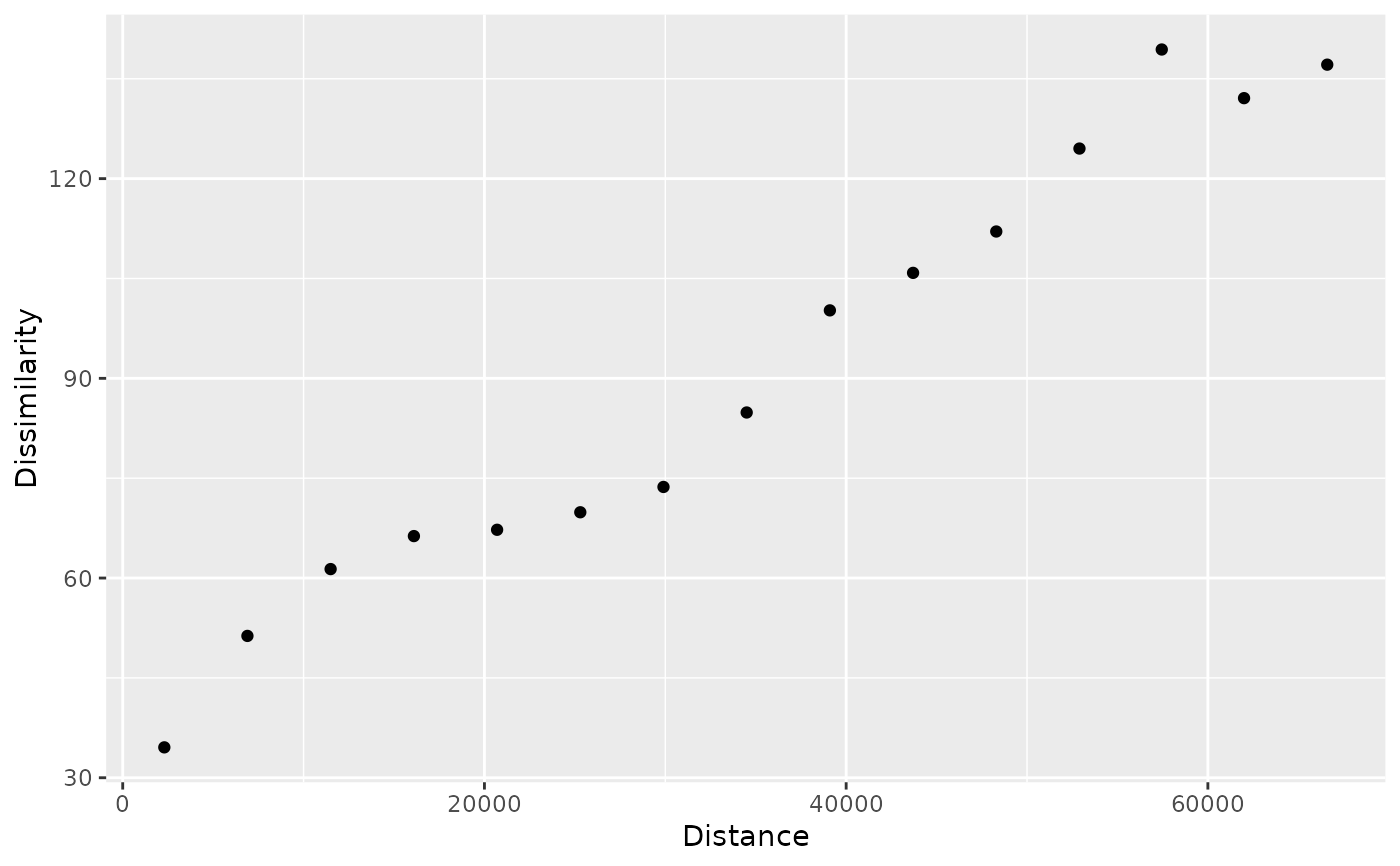It creates a patternogram or a patternogram cloud. The function takes a raster object of class SpatRaster or a point vector object of class sf as input, and calculates the dissimilarity between values of pairs of points given the distances between them. The output of this function is a tibble of the patternogram class that can be visualized with the plot() and autoplot() functions.
Arguments
- x
A raster object of class SpatRaster (terra) or a point vector object of class sf (sf)
- cutoff
Spatial distance up to which point pairs are included in patternogram estimates. By default: a square root of the raster/point data area
- breaks
Either the number of distance intervals (breaks) to be used in calculations, or a numeric vector specifying the break points. If a single number is provided, it specifies the number of intervals, and the function will create equally spaced intervals from 0 to
cutoff. By default: 15- dist_fun
Distance measure used. This function uses the
philentropy::distance()function (runphilentropy::getDistMethods()to find possible distance measures). By default: "euclidean"- sample_size
Only used when
xis raster. Proportion of the cells/points to be used in calculations. Value between 0 and 1. It is also possible to specify an integer larger than 1, in which case the specified number of cells/points will be used in calculations by random sampling. By default: 500- interval
Type of interval to be calculated. Options are "none" (default), "confidence" (confidence intervals around the mean dissimilarity estimate), and "uncertainty" (uncertainty intervals around the dissimilarity estimates). The confidence intervals are calculated using a bootstrap approach, while the uncertainty intervals are calculated using a Monte Carlo approach. Note that uncertainty intervals require more computations than confidence intervals. Also, confidence intervals are only available when
cloud = FALSE.- interval_opts
A list of options for interval calculations. Possible options are (a)
conf_level: confidence level for intervals (default: 0.95), (b)n_bootstrap: number of bootstrap samples for confidence intervals (default: 100), and (c)n_montecarlo: number of Monte Carlo repetitions for uncertainty intervals (default: 100)- group
Optional; name of a column in the point attribute table to calculate separate patternograms for different categories or ranges of a numeric variable. If the specified column is numeric, it will be converted to a factor using the
base::cut()function. By default: NULL- cloud
Logical; if TRUE, return the patternogram cloud
- ...
Not used
Value
A tibble of the patternogram class with columns (a) np: the number of point pairs in this estimate, (b) dist: the middle of the distance interval used for each estimate, (c) dissimilarity: the dissimilarity estimate.
Additionally, if interval = "confidence", the tibble contains columns (d) ci_lower: lower confidence interval, and (e) ci_upper: upper confidence interval. If interval = "uncertainty", the tibble contains columns (d) ui_lower: lower uncertainty interval, and (e) ui_upper: upper uncertainty interval.
If group is specified, the tibble also contains a column (f) group: the group category.
Also note, that if interval = "uncertainty", the np is the mean number of point pairs across Monte Carlo repetitions, and the dissimilarity is the mean dissimilarity across Monte Carlo repetitions.
If cloud = TRUE, the outcome is a tibble of the patternogram class with columns (a) left: ID of the first point in the pair, (b) right: ID of the second point in the pair, (c) dist: the spatial distance between the points in the pair, and (d) dissimilarity: the dissimilarity between the values of the points in the pair.
If group is specified, the tibble also contains a column (e) group: the group category.
Examples
r = terra::rast(system.file("ex/elev.tif", package = "terra"))
pr = patternogram(r)
#> Metric: 'euclidean' with unit: 'log'; comparing: 500 vectors
pr
#> # A patternogram: 15 × 3
#> np dist dissimilarity
#> * <int> <dbl> <dbl>
#> 1 2908 2300 39.7
#> 2 7957 6895 50.5
#> 3 11262 11495 57.0
#> 4 13657 16100 61.2
#> 5 14422 20700 66.4
#> 6 14203 25300 73.9
#> 7 13411 29900 77.9
#> 8 11911 34500 88.2
#> 9 9442 39100 106.
#> 10 8162 43700 121.
#> 11 6502 48300 135.
#> 12 4596 52900 154.
#> 13 2947 57450 169.
#> 14 1850 62000 182.
#> 15 969 66600 196.
plot(pr)
